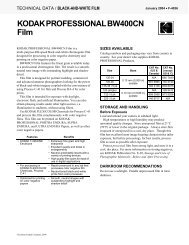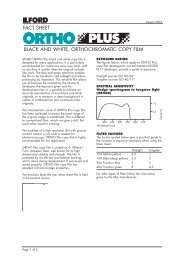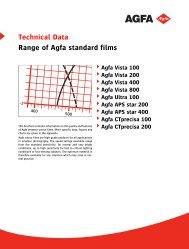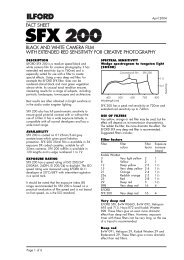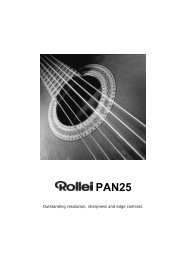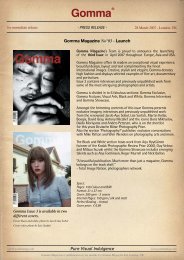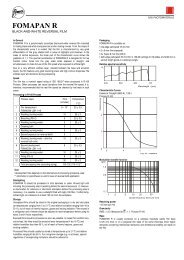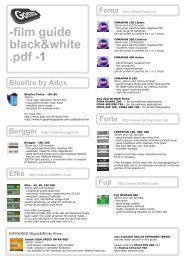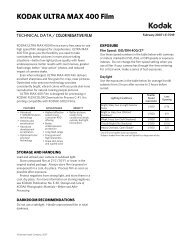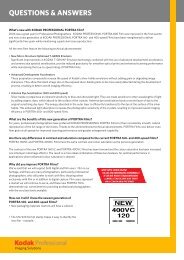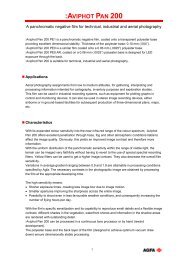KODAK EKTACHROME 64T Professional Film - Gomma
KODAK EKTACHROME 64T Professional Film - Gomma
KODAK EKTACHROME 64T Professional Film - Gomma
You also want an ePaper? Increase the reach of your titles
YUMPU automatically turns print PDFs into web optimized ePapers that Google loves.
TECHNICAL DATA / COLOR REVERSAL FILM<br />
September 2005 • E-130<br />
<strong>KODAK</strong> <strong>EKTACHROME</strong> <strong>64T</strong><br />
<strong>Professional</strong> <strong>Film</strong><br />
This medium-speed color transparency film features<br />
excellent color reproduction, very fine grain, and very high<br />
sharpness. It is designed for exposure with tungsten<br />
illumination<br />
(3200 K). The film is an excellent choice for photographing<br />
products, room interiors, titles, and artwork. Primary<br />
applications include catalog, furniture, and architectural<br />
photography, and copying.<br />
<strong>KODAK</strong> <strong>EKTACHROME</strong> <strong>64T</strong> <strong>Professional</strong> <strong>Film</strong> has an<br />
intended exposure range of 1/10,000 second to 10 seconds.<br />
Use this film to produce color transparencies for viewing<br />
with 5000 K illumination. You can also use the<br />
transparencies for printing by photomechanical methods and<br />
by photographic methods of direct duplication and direct<br />
reversal printing. In addition, you can scan transparencies for<br />
digital printing and for graphic arts and photo CD<br />
applications.<br />
FEATURES<br />
• Accurately records<br />
neutral colors<br />
• Outstanding reciprocity<br />
characteristics<br />
• Balanced for 3200 K<br />
(tungsten) studio lamps<br />
BENEFITS<br />
• Excellent color reproduction<br />
• Ideal for catalog, architectural,<br />
and commercial applications<br />
• Consistent color balance and<br />
speed over a wide range of<br />
exposure times<br />
• Good choice for photographing<br />
still lifes, making titles using a<br />
copy stand, and copying artwork<br />
SIZES AVAILABLE<br />
Sizes and catalog numbers may differ from country to<br />
country. See your dealer who supplies <strong>KODAK</strong><br />
PROFESSIONAL Products.<br />
Rolls <strong>Film</strong> Code Acetate Base<br />
135-36 EPY<br />
35 mm x 100-ft EPY / SP404<br />
5-mil<br />
(0.13 mm)<br />
35 mm x 400-ft EPY / SP663<br />
120 EPY<br />
Sheets<br />
4 x 5<br />
<strong>Film</strong> Code<br />
5 x 7<br />
EPY<br />
8 x 10<br />
<strong>KODAK</strong> PROFESSIONAL READYLOAD<br />
Single-Sheet Packet<br />
4 x 5 EPY<br />
3.9-mil<br />
(0.10 mm)<br />
ESTAR Thick<br />
Base<br />
7-mil<br />
(0.18 mm)<br />
7-mil<br />
(0.18 mm)<br />
†For use with the <strong>KODAK</strong> READYLOAD Packet <strong>Film</strong> Holder or other<br />
holders such as the POLAROID Model 545i <strong>Film</strong> Holder.<br />
STORAGE AND HANDLING<br />
Load and unload roll film in subdued light. Load and unload<br />
sheet film in total darkness using light-tight film holders.<br />
Store unexposed film in a refrigerator at 13°C (55°F) or<br />
lower in the original sealed package. To avoid moisture<br />
condensation on film that has been refrigerated, allow the<br />
film to warm up to room temperature before opening the<br />
package.<br />
Process film as soon as possible after exposure.<br />
Protect transparencies from strong light, and store them in<br />
a cool, dry place. For more information, see <strong>KODAK</strong><br />
Publication No. E-30, Storage and Care of <strong>KODAK</strong><br />
Photographic Materials—Before and After Processing.<br />
©Eastman Kodak Company, 2005
DARKROOM RECOMMENDATIONS<br />
Do not use a safelight. Handle unprocessed film in total<br />
darkness.<br />
EXPOSURE<br />
Exposure Index Numbers<br />
Use the exposure index numbers below with cameras or light<br />
meters marked for ISO or ASA speeds or exposure indexes<br />
(EI). Do not change the film-speed setting when metering<br />
through a filter. Metering through filters may affect meter<br />
accuracy; see your meter or camera manual for specific<br />
information. For critical work, make a series of test<br />
exposures.<br />
Light Source<br />
<strong>KODAK</strong><br />
WRATTEN<br />
Gelatin Filter<br />
Exposure<br />
Index<br />
Tungsten (3200 K) None 64<br />
Photolamp (3400 K) 81A 50<br />
Daylight or Electronic Flash 85B 40<br />
Tungsten Light<br />
For best color rendition, use tungsten photolamps (3200 K)<br />
at their rated voltage. If voltage varies significantly, the color<br />
of the lamp will change. Other light sources may not give<br />
equally good results, even with filters. Unless you want a<br />
special effect, do not mix light sources, particularly tungsten<br />
light and daylight.<br />
Fluorescent and High-Intensity Discharge<br />
Lamps<br />
Use the color-compensating filters and exposure adjustments<br />
below as starting points to expose this film under fluorescent<br />
or high-intensity discharge lamps. For critical applications,<br />
make a series of test exposures under your actual conditions.<br />
Vary the recommended filtration by at least ±CC10, and<br />
increase or decrease exposure accordingly.<br />
To avoid the brightness and color variations that occur<br />
during a single alternating-current cycle, use exposure times<br />
of 1/60 second or longer with fluorescent lamps; with<br />
high-intensity discharge lamps, use exposure times of<br />
1/125 second or longer.<br />
Fluorescent<br />
Lamps<br />
<strong>KODAK</strong> Color<br />
Compensating<br />
Filters<br />
Exposure<br />
Adjustment<br />
Daylight No. 85B + 40M + 30Y +1 2/3 stops<br />
White 50R + 10M +1 1/3 stops<br />
Warm White 50M + 40Y +1 stop<br />
Warm White Deluxe 10R +1/3 stop<br />
Cool White 60R +1 1/3 stops<br />
Cool White Deluxe 20M + 40Y +2/3 stop<br />
Unknown Fluorescent * 50R + 1 stop<br />
*When the type of fluorescent lamp is unknown, try this filter and exposure<br />
adjustment; color rendition may be less than optimum.<br />
High-Intensity<br />
Discharge Lamps<br />
<strong>KODAK</strong> Color<br />
Compensating<br />
Filters<br />
Exposure<br />
Adjustment<br />
General Electric Lucalox * 50M + 20C +1 stop<br />
General Electric<br />
60R + 20Y +1 2/3 stops<br />
Multi-Vapor<br />
Deluxe White Mercury 70R + 10Y +1 2/3 stops<br />
Clear Mercury 90R + 40Y +2 stops<br />
* This is a high-pressure sodium-vapor lamp. The information in the table<br />
may not apply to other manufacturers' high-pressure sodium-vapor<br />
lamps due to differences in spectral characteristics.<br />
Note: Consult the manufacturer of high-intensity lamps for<br />
ozone ventilation requirements and safety information on<br />
ultraviolet radiation.<br />
Some primary color filters were used in the previous<br />
tables to reduce the number of filters and keep the exposure<br />
adjustment to a minimum. Red filters were substituted for<br />
equivalent filtration in magenta and yellow. Blue filters were<br />
substituted for equivalent filtration in cyan and magenta.<br />
2 <strong>KODAK</strong> <strong>EKTACHROME</strong> <strong>64T</strong> <strong>Professional</strong> <strong>Film</strong> • E-130
Adjustments for Long and Short Exposures<br />
No filter correction or exposure compensation is normally<br />
required for <strong>EKTACHROME</strong> <strong>64T</strong> <strong>Professional</strong> <strong>Film</strong> at<br />
exposure times of 1/10,000 second to 10 seconds. For a<br />
100-second exposure, increase exposure by 1/3 stop and add<br />
a CC05R filter.<br />
For more specific information when using sheet film, see<br />
the product packaging. Exposure index and filter<br />
recommendations for the specific emulsion number are<br />
listed on the box. Included are recommendations at 1/10, 5,<br />
30, and 100 seconds.<br />
PROCESSING<br />
Process <strong>EKTACHROME</strong> <strong>64T</strong> <strong>Professional</strong> <strong>Film</strong> in <strong>KODAK</strong><br />
Chemicals, Process E-6.<br />
For consistent processing of this and all other<br />
<strong>EKTACHROME</strong> <strong>Film</strong>s, use a lab that is a member of the<br />
<strong>KODAK</strong> Q-LAB Process Monitoring Service.<br />
PRINTING TRANSPARENCIES<br />
You can reproduce images made on <strong>EKTACHROME</strong> <strong>64T</strong><br />
<strong>Professional</strong> <strong>Film</strong> by using a variety of Kodak materials:<br />
Duplicate Color Transparencies<br />
For direct printing, use—<br />
<strong>KODAK</strong> PROFESSIONAL <strong>EKTACHROME</strong><br />
Duplicating <strong>Film</strong> EDUPE<br />
Color Prints<br />
You can scan your image to a file and print digitally to—<br />
<strong>KODAK</strong> PROFESSIONAL PORTRA, SUPRA, and<br />
ULTRA ENDURA Papers<br />
<strong>KODAK</strong> PROFESSIONAL ENDURA Clear Digital<br />
Display Material<br />
<strong>KODAK</strong> PROFESSIONAL ENDURA Transparency<br />
Display Material<br />
<strong>KODAK</strong> PROFESSIONAL ENDURA Metallic Paper<br />
RETOUCHING<br />
Use <strong>KODAK</strong> E-6 Transparency Retouching Dyes. You can<br />
chemically retouch sheet and 120-size film on both the base<br />
and the emulsion side. Retouch only the emulsion side on the<br />
135 size. For information on retouching equipment, supplies,<br />
and techniques, see <strong>KODAK</strong> Publication No. E-68,<br />
Retouching Transparencies on <strong>KODAK</strong> <strong>EKTACHROME</strong><br />
<strong>Film</strong>.<br />
<strong>KODAK</strong> <strong>EKTACHROME</strong> <strong>64T</strong> <strong>Professional</strong> <strong>Film</strong> • E-130 3
SCANNING TRANSPARENCIES<br />
For Graphic Arts Applications<br />
The <strong>KODAK</strong> <strong>EKTACHROME</strong> <strong>Film</strong> family is characterized<br />
by sets of image dyes which perform similarly when<br />
scanned. The scanner operator can set up one basic tone scale<br />
and color-correction channel for all <strong>EKTACHROME</strong> <strong>Film</strong>s<br />
and then optimize the tone scale and gray balance for the<br />
requirements of individual images.<br />
Use the <strong>KODAK</strong> Color Input Target / Q-60E1 (4 x 5inch<br />
transparencies) or Q-60E3A (35 mm slide) to establish the<br />
setup for <strong>KODAK</strong> <strong>EKTACHROME</strong> <strong>Film</strong>s on all scanners.<br />
This target meets ANSI standards and represents the dye sets<br />
of all <strong>EKTACHROME</strong> <strong>Film</strong>s.<br />
For Photo CD Applications<br />
Use the Universal E-6 <strong>Film</strong> Term to scan all <strong>KODAK</strong><br />
<strong>EKTACHROME</strong> films for Photo CD Imaging Workstation<br />
applications.<br />
For Output to a Photo CD Player: Using the Universal E-6<br />
<strong>Film</strong> Term should result in an image that closely matches<br />
your original transparency in density, tone scale, and overall<br />
color balance when viewed on a player.<br />
For Output to Devices Other than Photo CD Players: The<br />
YCC data that results when using the Universal E-6 <strong>Film</strong><br />
Term is capable of producing a high-quality duplicate of<br />
your original transparency in terms of density, tone scale,<br />
and color reproduction. Final quality of your reproduced<br />
image depends on the capabilities of your output device, the<br />
viewing environment, and the rendering path used.<br />
4 <strong>KODAK</strong> <strong>EKTACHROME</strong> <strong>64T</strong> <strong>Professional</strong> <strong>Film</strong> • E-130
CURVES<br />
Diffuse rms Granularity * 11 (very fine)<br />
2.0<br />
Spectral-Sensitivity Curve<br />
*Read on a gross diffuse visual density of 1.0, using a 48-micrometre<br />
aperture, 12X magnification.<br />
DENSITY<br />
4.0<br />
3.0<br />
2.0<br />
1.0<br />
G B<br />
R<br />
0.0<br />
3.0<br />
F009_0002AC<br />
RESPONSE (%)<br />
200<br />
100<br />
70<br />
50<br />
30<br />
20<br />
10<br />
7<br />
5<br />
3<br />
2<br />
1<br />
1<br />
F009_0001AC<br />
Characteristic Curves<br />
2.0<br />
Exposure: Tungsten 1/10 second<br />
Process: E-6<br />
Densitometry: Status A<br />
1.0 0.0 1.0<br />
LOG EXPOSURE (lux-seconds)<br />
Modulation-Transfer Curve<br />
Exposure: Tungsten<br />
Process: E-6<br />
Densitometry: Diffuse Visual<br />
2<br />
3<br />
45<br />
10<br />
20<br />
50<br />
100<br />
SPATIAL FREQUENCY (cycles/mm)<br />
200<br />
600<br />
*<br />
LOG SENSITIVITY<br />
1.0<br />
Yellow-<br />
Forming<br />
Layer<br />
0.0<br />
Magenta- Cyan-<br />
Forming Forming<br />
Effective Exposure:<br />
Layer Layer<br />
1.0 1.4 seconds<br />
Process: E-6<br />
Densitometry: E.N.D.<br />
Density: E-6<br />
2.0<br />
250 300 350 400 450 500 550 600 650 700<br />
WAVELENGTH (nm)<br />
*Sensitivity = reciprocal of exposure (ergs/cm ) required<br />
to produce specified density<br />
F009_0003AC<br />
DIFFUSE SPECTRAL DENSITY<br />
1.5<br />
1.0<br />
0.5<br />
0.0<br />
400<br />
F009_0004AC<br />
Spectral-Dye-Density Curves<br />
Normalized dyes to form a visual neutral density<br />
of 1.0 for a viewing illuminant of 5000 K.<br />
Process: E-6<br />
Yellow<br />
Magenta<br />
500<br />
600<br />
WAVELENGTH (nm)<br />
NOTICE: The sensitometric curves and data in this<br />
publication represent product tested under the conditions of<br />
exposure and processing specified. They are representative<br />
of production coatings, and therefore do not apply directly to<br />
a particular box or roll of photographic material. They do not<br />
represent standards or specifications that must be met by<br />
Eastman Kodak Company. The company reserves the right<br />
to change and improve product characteristics at any time.<br />
2<br />
Visual Neutral<br />
Cyan<br />
700<br />
750<br />
<strong>KODAK</strong> <strong>EKTACHROME</strong> <strong>64T</strong> <strong>Professional</strong> <strong>Film</strong> • E-130 5
<strong>KODAK</strong> <strong>EKTACHROME</strong> <strong>64T</strong> <strong>Professional</strong> <strong>Film</strong><br />
MORE INFORMATION<br />
Kodak has many publications to assist you with information<br />
on Kodak products, equipment, and materials.<br />
The following publications are available from Kodak<br />
Customer Service, from dealers who sell Kodak products, or<br />
you can contact Kodak in your country for more information.<br />
E-8 <strong>KODAK</strong> <strong>EKTACHROME</strong> 64 <strong>Professional</strong> <strong>Film</strong><br />
E-27 <strong>KODAK</strong> <strong>EKTACHROME</strong> 100 <strong>Professional</strong> <strong>Film</strong><br />
E-28 <strong>KODAK</strong> PROFESSIONAL <strong>EKTACHROME</strong><br />
<strong>Film</strong> E200<br />
E-30 Storage and Care of <strong>KODAK</strong> Photographic<br />
Materials—Before and After Processing<br />
E-31 Reciprocity and Special Filter Data for <strong>KODAK</strong><br />
<strong>Film</strong>s<br />
E-38 <strong>KODAK</strong> <strong>EKTACHROME</strong> Duplicating <strong>Film</strong>s<br />
E-68 Retouching Transparencies on <strong>KODAK</strong><br />
<strong>EKTACHROME</strong> <strong>Film</strong><br />
E103RF <strong>KODAK</strong> PROFESSIONAL Color Reversal<br />
<strong>Film</strong>s<br />
E-113 <strong>KODAK</strong> <strong>EKTACHROME</strong> 100 Plus <strong>Professional</strong><br />
<strong>Film</strong><br />
E-144 <strong>KODAK</strong> <strong>EKTACHROME</strong> 160T <strong>Professional</strong><br />
<strong>Film</strong><br />
E-145 <strong>KODAK</strong> <strong>EKTACHROME</strong> 320T <strong>Professional</strong><br />
<strong>Film</strong><br />
E-147 <strong>KODAK</strong> <strong>EKTACHROME</strong> P1600 <strong>Professional</strong><br />
<strong>Film</strong><br />
E-161 <strong>KODAK</strong> <strong>EKTACHROME</strong> 400X <strong>Professional</strong><br />
<strong>Film</strong><br />
E-163 <strong>KODAK</strong> PROFESSIONAL <strong>EKTACHROME</strong><br />
<strong>Film</strong> E100VS<br />
E-4024 <strong>KODAK</strong> PROFESSIONAL <strong>EKTACHROME</strong><br />
<strong>Film</strong>s E100G and E100GX<br />
E-2529 <strong>KODAK</strong> PROFESSIONAL <strong>EKTACHROME</strong><br />
Duplicating <strong>Film</strong> EDUPE<br />
For the latest version of technical support publications for<br />
<strong>KODAK</strong> PROFESSIONAL Products, visit Kodak on-line at:<br />
http://www.kodak.com/go/professional<br />
If you have questions about <strong>KODAK</strong> PROFESSIONAL<br />
Products, call Kodak.<br />
In the U.S.A.:<br />
1-800-242-2424, Ext. 19, Monday–Friday<br />
9 a.m.–7 p.m. (Eastern time)<br />
In Canada:<br />
1-800-465-6325, Monday–Friday<br />
8 a.m.–5 p.m. (Eastern time)<br />
Note: The Kodak materials described in this publication for<br />
use with <strong>KODAK</strong> <strong>EKTACHROME</strong> <strong>64T</strong> <strong>Professional</strong> <strong>Film</strong><br />
are available from dealers who supply <strong>KODAK</strong><br />
PROFESSIONAL Products. You can use other materials,<br />
but you may not obtain similar results.<br />
EASTMAN <strong>KODAK</strong> COMPANY<br />
<strong>KODAK</strong> <strong>EKTACHROME</strong> <strong>64T</strong><br />
<strong>Professional</strong> <strong>Film</strong><br />
<strong>KODAK</strong> Publication No. E-130<br />
CAT 198 5910<br />
Kodak, Kodak <strong>Professional</strong>, Readyload, Ektachrome, Endura, Portra, Q-Lab, Supra,<br />
Ultra, and Wratten are trademarks.<br />
Minor Revision 9-05<br />
Printed in U.S.A.




